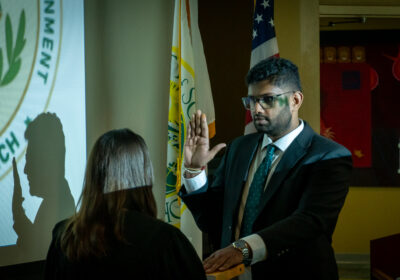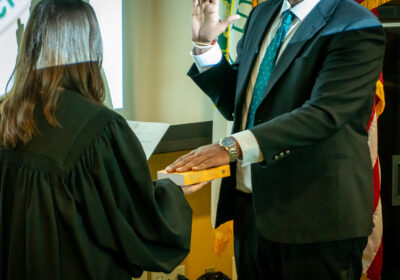Getting the most out of a gallon
Gas prices are unstable in an economic decline, and for students driving to campus five days a week, every little bit of gas saved is worthwhile. There are some basic tips and tricks to save gas mileage on a daily basis – without buying a new hybrid.
Steady driving
The first step toward steady driving is moderating starts and stops at traffic lights. The faster a car accelerates, the more gas it uses, so flooring the gas pedal the instant the traffic light turns green is a great way to waste gas, according to the Environmental Protection Agency.
Changing red light stops by not always coming to a complete stop helps cars gain speed without using a lot of gas. When approaching a red light, especially if it is likely to turn green by the time the car gets to the white line, start slowing down at a greater distance from the light.
By coasting slowly toward the light, the car maintains some of its forward momentum, which means it needs less force and less gas to accelerate if the light turns green. It will also save wear and tear on tires and brake pads, according to motorists.org, the National Motorists Association Web site.
In traffic, this is also useful. Instead of pressing the gas pedal to move closer to the next car when the lane starts moving, just take your foot off the brake and coast.
While in constant movement, like on highways, the same principle of acceleration applies. If the car has a cruise control function, using it on level road to maintain a constant speed is beneficial to gas mileage, according to opentravelinfo.com.
Going the speed limit can save on gas, too: Not only does it help avoid unnecessary speeding tickets, but most speed limits are between 45 to 60 mph. This is often referred to as the “sweet spot,” or the speed at which a car gets the best mileage.
Motorists.org recommends staying as close to the “sweet spot” as possible, even if it means moving to the right lane in yielding to faster traffic. But don’t risk being a hazard and going too far below the speed limit just to save gas.
One little-known, gas-saving tip, proven on the TV show “Myth Busters,” is staying in the slipstream of a large truck or semi on long trips. This reduces the amount of air resistance against the car. However, while this tip can save gas mileage, it isn’t recommended because it can be unsafe.
Idling unnecessarily will also waste gas, so find CDs and adjust mirrors before turning on the car. But don’t put your car in neutral when sitting at a red light or coasting downhill. Often, this can actually be worse for gas mileage.
Car maintenance
Keeping a car in good condition is important for its health and is also a good way to improve gas mileage.
During the 2008 presidential election, President Barack Obama mentioned that regular tune-ups and properly inflated tires can save Americans money in oil.
According to the National Wildlife Federation’s Web site, NWF.org, which provides tips for helping the planet, under-inflated tires can cause a 10 percent increase in gas usage. This is because under-inflated tires have more road resistance.
Motorists.org recommends keeping tires at the highest possible PSI level, which is usually posted on the tire and is higher than the amount in the owner’s manual. Unfortunately, this can also wear out tires faster.
The Department of Energy also claims a 3.3 percent decrease in gas usage from having tires at the right level and by keeping a car regularly maintained.
Removing weight from the car, whether it’s boxes of stuff or entire car seats, can also improve mileage.
Generally, any resistance on a car will have a negative impact on mileage. The more aerodynamically sound a car is, the less effort and gas it will take to move through the air. Anything that adds more surface area to the car, like bike or luggage racks, should be removed when not in use.
Using the correct oil and regularly changing air filters will reduce friction within the vehicle. Some sites and car experts even say a regular wash and wax can reduce friction, but this has yet to be scientifically proven.
Check prices and re-route
Checking gas prices is an easy way to save money where the spending starts. Web sites like tampagasprices.com list gas stations by cheapest or most expensive gas and constantly update their listings with the help of other drivers.
Sunday night, the Murphy USA station on Gunn Highway had one of the lowest gas prices, $2.60 per gallon, while the Shell station on NW Shore Boulevard and Cypress Avenue had one of the most expensive at $2.79.
Re-route trips to take advantage of a car’s “sweet spot” and avoid traffic. Find back roads and highways where it is easy to keep one speed and avoid red lights.
Eliminate unnecessary trips
While this may seem like common sense, you may be missing out on the easiest way to save gas: drive less.
Bringing a shopping list will prevent forgetting items and repeat trips. Try combining trips and shopping once a month, rather than every time you make dinner. Buy foods that last longer or plan menus in advance, so there is no need to go grocery shopping as often.
Brown-bagging meals rather than going off-campus to eat will not only save restaurant travel miles, but will also negate the need to look for a parking spot upon return.
Since searching for parking can be a major gas-waster, try timing your campus arrival on the hour, or every 15 minutes, when classes are getting out and people are leaving campus.
Don’t ignore opportunities to ride a bike or walk to campus. Especially since the weather is cooling down, not driving at all is the best way to save gas and stay healthy. If it’s too far to bike or walk, try finding people to car pool with and alternate driving days.
For more gas saving tips, visit epa.gov and search for “gas saving tips.”






